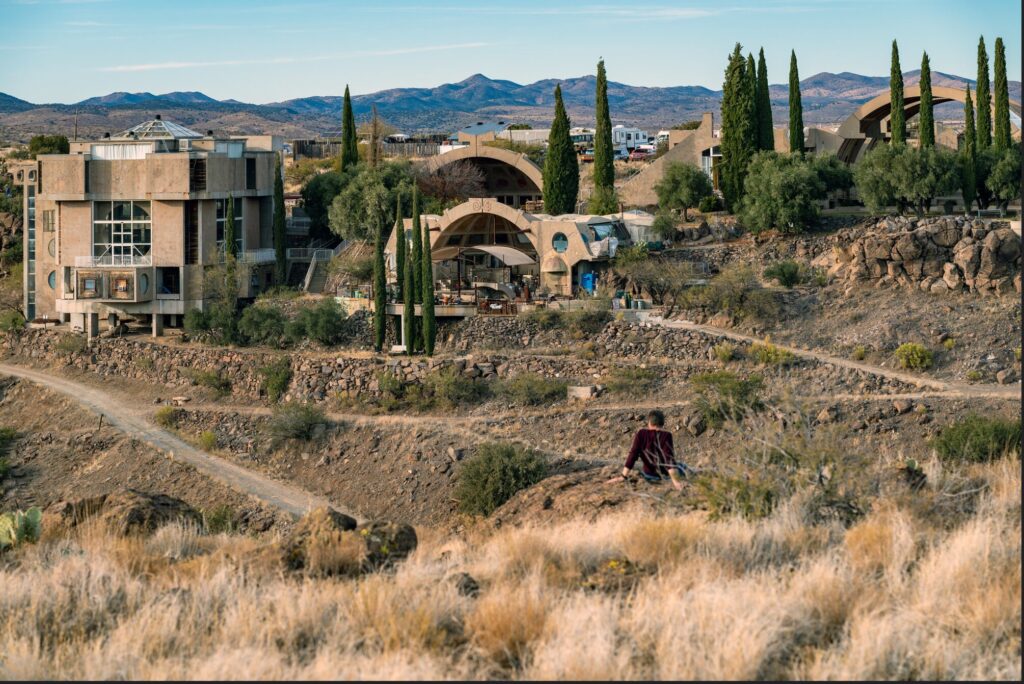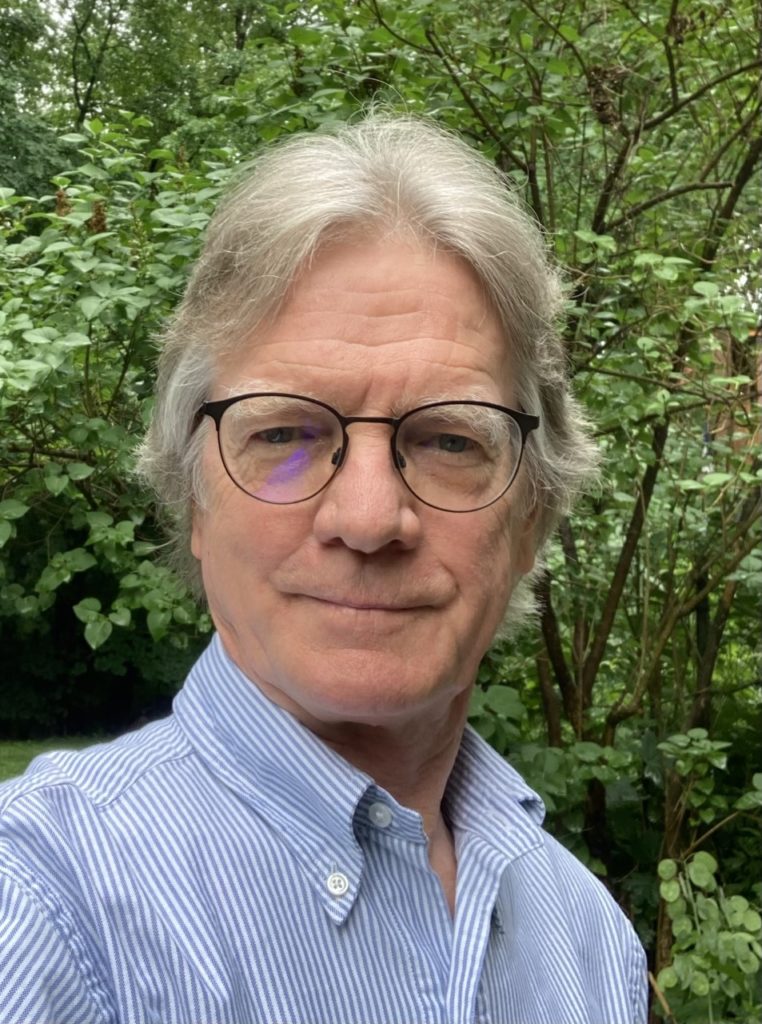Opinion: Better Ideas for Development in Leverett

Arcosanti, Arizona 2023, Photo: Space]rucker[ /Flckr.com. (CC BY-ND 2.0) DEED
An abridged version of this column appeared previously in the Amherst Bulletin.

Am I racist?
This is certainly what some real estate people want you to think, based on nearly a full page of their comments in the Daily Hampshire Gazette and Amherst Bulletin (see here and here) regarding the developing of the Kitteridge estate for housing. More broadly, they made claims that small town zoning regulations are ipso facto discriminatory if they include features like lot size limits, and restrictions on multi-family housing. These sentiments are echoed by some politicians, from the local to the national level.
This begs many more questions: What does it mean to “live in the land of opportunity”? Is the notion of working hard to buy a property one can protect and invest not just money, but physical work, time and love, inherently racist? Are people who do not want to live in urban congestion, noise, pollution, etc. actually just crypto-racists? Are communities of like-minded people necessarily discriminatory? Do we have to resort to some sort of societal lottery system to assign housing “fairly”, and at what income level would people of wealth be able to buy their way out of it?
I was among the first people to live in Arcosanti in the mid ’70’s, brought in to build the first ceramics studio there. Perched on a mesa in rural Arizona, it was the first example of what its designer, Paolo Solari, envisioned as a fusion of architecture and ecology, which sought to provide high-density living in an organic, appealing megastructure that would leave the surrounding land open for agriculture, and wilderness. The group of craftspeople I was a part of were sympathetic to the ideas of making urban living more wholesome and sparing arable land and natural areas from development. Unlike his devoted apostles already there, we were not shy to question the old man. At one point I asked him, “Who gets to live in the corner apartments with good views?” He was dismissive, and haughtily told me that was not his concern, that he just designed the structures others would live in. The question went unanswered, then, and now.
I do not have an answer, beyond money. But I vehemently reject the idea that protecting my 1/3rd of an acre, my ’60’s ranch house, and the little neighborhood I live in in Amherst from the encroachment of investor-owned student houses is racist or elitist. Furthermore, the idea that a proposed development that includes an existing multimillion dollar sports building and a palatial mansion is going to be “mixed income housing” sounds like poppycock.
Like so much in the real estate development world, a few investment LLC’s and people of extravagant means are cornering the market. The tax breaks available to them and the death of the estate tax have meant wealth is slowly being consolidated into ever-fewer hands. Renters are being squeezed, and many working families can no longer afford the dream of home ownership, as investors, corporate or individual, pay cash well above the asking price to buy houses for rental conversions. More than a fifth of all houses sold last year were sold to investors. This does not bode well for equality and stability. The ability of working-class families to own their own homes is an economic buffer against the societally corrosive consolidation of wealth we are now witnessing.
Seeing fatal flaws in the scheme to develop a woodsy Xanadu into a housing complex of 700 units is not inherently racist. It is a plea for reason, and for fairness for the residents who currently call Leverett home. Leverett has a total population of less than 1900. The average American household in 2022 had 2.5 people, which means that a 700 unit development would add approximately 1750 people to the town, nearly doubling its population. It would greatly overburden the local elementary school, the water and sewer hook ups (to be requestioned from Amherst), the police and fire coverage, and the roads near the development. Many small towns have gotten on the development-as-salvation treadmill, only to find they have sacrificed what they had for an endless game of fiscal catch-up, trying to finance basic infrastructure projects and additional demands for various services that a rapid jump in population spawns. Somewhat more insidiously, it would distort the politics of the town, which still sets priorities and spending through a town meeting. In essence, it would destroy the civic structure and character of a small town about to celebrate its 250th birthday. Speaking out against that is being labeled as “racist” or “elitist” primarily by people who make a lot of money off development, urbanites wishing to off-load some of their population to outlying towns, and people of a political bent that sees racist evil everywhere, and whose remedies primarily and adversely affect middle-class residents.
The Kitteridge family and their prospective developers have options. Yankee Candle sold a few years ago for nearly half a billion dollars. The $23M price tag for the Leverett estate (which is grossly under-assessed at around $10.5M) is “walking around money” for people in that income bracket. Waiting for another buyer is hardly an economic hardship. Better yet, developing the estate into a senior living community or an arts or environmental or cultural education center would enhance the community while demanding less in terms of infrastructure investment. A couple decades ago, the Kitteridge estate was assembled by purchasing several perfectly good private homes and demolishing them for their acreage. (Real estate availability being less of an issue then…) The family now has a choice in their plans for getting rid of the family estate: to be known for helping to degrade Leverett and snarling traffic in North Amherst, or for enhancing the town their father chose as his home.
John Varner is a resident of Amherst’s District 3

Thank you John for setting the record straight. I seconded some of your points in a letter to the editor recently:
“Leverett’s zoning is restrictive because there is no sewer infrastructure and only private wells so the aquifers must be protected. These are health and environmental issues having nothing to do with “redlining”, a “lack of virtue” on behalf of those who question the project or any other social problem. Another op-ed titled “Welcome to neighborhood in Leverett” suggests the same sort of discrimination among Leverett residents questioning the development. That op-ed claims the Kittridge property would “support marginalized communities in practice”. To the contrary, the present plan (such as it is) aims to create high-end housing only the wealthy could afford with a smattering of enough alleged low-income housing to override zoning concerns. Why are people from out of town promoting more unaffordable housing in Leverett? Follow the money.”
Kudos to John Varner for focusing on our local version of a much larger battle being played out in capitalist society. Those with lots of money (an elite group for sure) who can benefit from the existing legal system to leverage profits in real estate need to be kept in check – unless quality of life for others and the environment is meaningless. This situation is not unlike the balance between predators and prey in (non-anthropocentric) nature and John is not elitist or racist, he is reasonable.